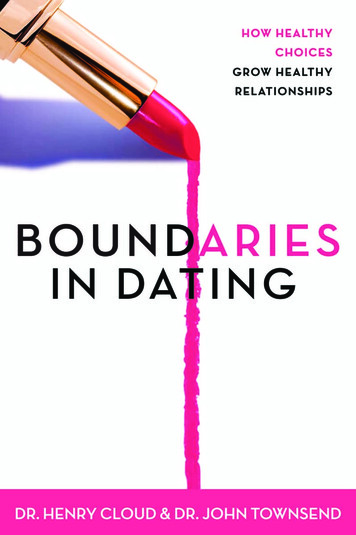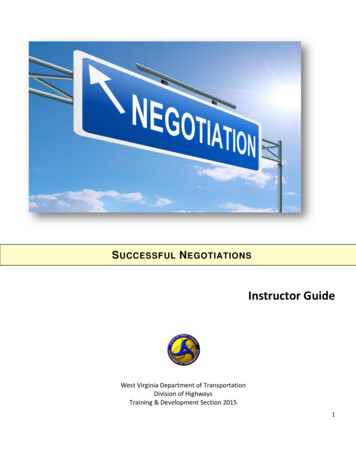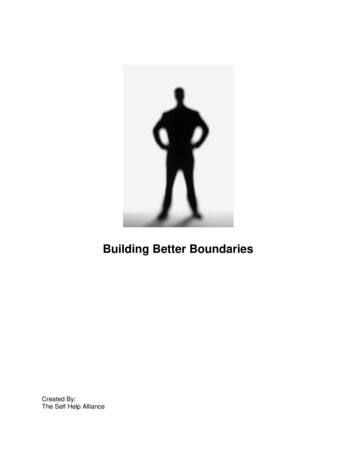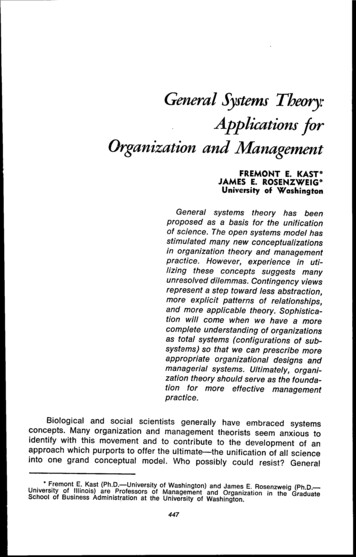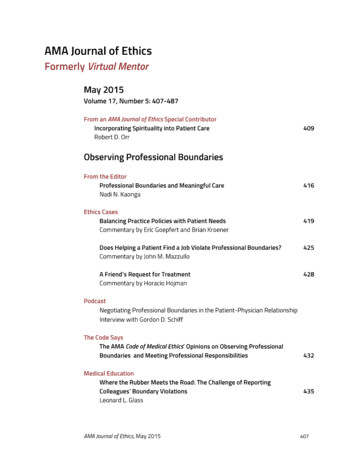
Transcription
Negotiating Professional Boundaries in the Patient-Physician Relationship407
408
American Medical Association Journal of EthicsMay 2015, Volume 17, Number 5: 409-415FROM AN AMA JOURNAL OF ETHICS SPECIAL CONTRIBUTORIncorporating Spirituality into Patient CareRobert D. Orr, MD, CMReligion and MedicineThe histories of medicine and religion have been interwoven for centuries. Many faithbased communities, organizations, and agencies established hospitals and hospices aspart of their ministry. In the modern era, however, the two became increasinglyseparated as medicine became more scientific, developing what became known as thebiomedical model in the mid-nineteenth century. During this period of secularization ofmedicine, some religious hospitals remained true to their faith-based mission, whilemany retained their religious identity in name only.In 1977, George Engel, a professor of psychiatry, wrote a classic article in which he urgedmedical educators, researchers, and practitioners to abandon the reductionist biomedicalmodel of disease and adopt a broader perspective that could incorporate “the social,psychological and behavioral dimensions of illness” [1]. He called his proposal thebiopsychosocial model. This new model was adopted rather widely in Western medicineover the next generation.In spite of this broader biopsychosocial perspective, or perhaps because of it, theboundary separating the practice of contemporary Western medicine from religionbecame more sharply delineated. When a patient or even a clinician raises a tenet ofreligious faith while discussing health care, one often hears the retort, “Medicine issecular; religion is sacred and private.” This answer implies that medicine in its threedimensions (biological, psychological, and social) specifically excludes the spiritualdimension that belongs to a sacred space that a patient need not talk about and thatneed not be considered in the clinician’s concept of caring for individuals. This distinctionis exemplified by the fact that, although nearly all hospitals offer chaplaincy services, inmost settings the chaplain is not viewed as part of the clinical team but as an ancillaryconsultant.In one sense, however, this recognition that religion is separate and distinct has againbroadened the concept of whole-person medicine so that it now encompasses fouroverlapping domains: biological, psychological, social, and spiritual. A few US medicalschools established in the last 175 years expanded the biomedical model, adding theconcept of caring for the whole person by including in their mission statements theimportance of a spiritual dimension in patient care [2, 3]. This development suggestsAMA Journal of Ethics, May 2015409
that health care professionals should have a better understanding of the patient’spersonal, cultural, and religious values.Religion and Medical EthicsAs medical technology began to expand rapidly in the 1960s and ’70s, offering means ofextending the lives of mortally ill people, some began to ask “should we ?” questions inaddition to “can we ?” questions. These are value-based questions, not clinical or evenscientific questions. Just because we can do something doesn’t mean that we should doit. Such questions arise very commonly today in situations involving end-of-life care,limitation of treatment, treatment of patients who have what is perceived by others tobe diminished quality of life, use of limited or expensive resources, and so on. Thesequestions are often discussed in bedside situations that are referred for consultationwith a clinical ethics consultant or committee. The idea that medicine is inherently amoral enterprise—that the practice of medicine involves making decisions between rightand wrong, good and bad—entered our conversation at this time of technologicalexpansion [4].When questions of right and wrong in medicine were first voiced, it was often by peopleof faith who recognized that religious traditions addressed these values. Indeed, theearly medical ethicists were primarily theologians coming from Roman Catholic,Protestant, and Jewish traditions [5]. Although the discipline has largely been taken overby philosophers, clinicians, the courts, and health policymakers, the roots of medicalethics are clearly faith based.How does the moral dimension of medicine comport with the above-mentionedboundary between medicine and faith? Quite easily, actually. Those involved in medicaldecisions are people: patients, families, professionals. All of these people have values,often based on faith.Foundations of Medical Ethics: Secular and Sacred PrinciplesAlthough there are several conceptualizations of medical ethics [6], probably the mostcommonly articulated in North America is principlism. While insufficient of and by itselfto thoroughly resolve all dilemmas in medical ethics, principlism is often the beginningpoint for such discussions. The secular principles of medical ethics are well known andhave been discussed at length in many settings [7]. The four foundational principles are(1) nonmaleficence (first of all, do no harm), (2) beneficence (always seek the patient’sbest interest), (3) respect for autonomy (the patient has a right to self-determination),and (4) justice (we should treat like patients alike, without discrimination). In modernWestern culture, respect for autonomy has become the “first” principle “among equals.”A person has the right to make his or her own decisions about medical treatment. Thisprinciple is often expressed as respect for persons. And, of course, patients are persons,complete with values, some of which are faith based.410www.amajournalofethics.org
The theologians who pioneered contemporary medical ethics also built their foundationon principles, but these were sacred. These sacred principles often parallel or overlap thefour secular principles. Elsewhere I have tried to identify some of the sacred preceptsand beliefs held by members of one or more of the three monotheistic faith traditions(Judaism, Christianity, Islam) that may be influential, sometimes even determinative, inresolving dilemmas in medical ethics [8]. I will outline 11 of them from my own Christianperspective, recognizing that there is much overlap with Jewish and Islamic perspectives.The Imago Dei (the image of God in man). From the first chapter of Genesis, the first bookof the Hebrew Bible, we learn that each individual, regardless of ability or disability, bearsthe image of God. This is inherent, not imputed, and may be difficult to understand as wecontemplate persons born with anencephaly or afflicted with severe dementia. Althoughsuch disabilities are part of the mortal nature of humankind, they do not detract from theunderlying principle.The sanctity of life. Because we bear the image of God, each human life is sacred. Humanlife is special; it is different from animal life. Our God-given dominion (see below) allowsus sometimes to end an animal’s life humanely, but it does not allow us intentionally toend a human life. This belief in the sanctity of life does not mean, however, that we mustalways attempt to postpone human death, another inevitable consequence of the Fall.The Fall, suffering, disease, and death. Because of Adam’s sin, we live in a fallen world withall its manifestations. We should try to relieve suffering. We should try to cure or controldisease. We should try to avoid death when possible. But, in the end, we are all finite.Quality of life. Some people of faith bristle when quality of life is mentioned, arguing thatwe should only focus on the sanctity of life. But we all experience a quality of life—good,bad, or neutral. And when the burdens of continued life make it impossible for us to carryout God’s purpose, we are not obligated to use disproportionate measures to forestalldeath.Miracles. Adherents of all three monotheistic faith traditions believe, based on their ownsacred texts, that God is capable of intervening in our lives in ways that we cannotexplain or understand, in ways that seem to contradict the laws of nature. Unfortunately,we tend to use the word “miracle” too loosely, as in “miracle drugs,” “miraculoussurvival,” and so on. True supernatural interventions are not common in my experience.But God can do such things when He chooses. In addition, He does not need ourmachines or procedures to accomplish His miracles.Compassion. God’s incomprehensible love for us is clearly reflected in the compassiontaught and demonstrated by Jesus. It is incumbent on us to remember that compassionAMA Journal of Ethics, May 2015411
means “to suffer with.” Some misinterpret the word to mean merciful ending of apatient’s life. Instead, in my view, we are called to do our utmost for patients’ suffering:to suffer along with them and not abandon them.The ministry of health care. Many religious health care professionals believe that the workwe do is a ministry to those in need, a way to show forth God’s love.The hope of eternity. Many people of faith believe that this life, with its suffering anddeath, is not all there is. We have the hope of eternal life with a loving God. Some peopleof faith believe that we should always hope for a good outcome to illness. Václav Havel,former president of the Czech Republic, insightfully wrote that hope “is not theconviction that something will turn out well, but the certainty that something makessense, regardless of how it turns out” [9].The sovereignty of God. As human beings, we live in a fallen world, beneath thesovereignty of an all-powerful God.Dominion and stewardship. God has granted us liberty, expecting us to make decisionsabout the use of our abilities and resources. In contemporary medicine, the timing ofdeath is often a matter of choice. The time of death for a patient may vary considerablybased on whether we choose to use cardiopulmonary resuscitation, ventilator support,dialysis, one more round of chemotherapy, antibiotics, or a feeding tube.Free will. Many people of faith equate the religious concept of free will and the secularconcept of autonomy. In one sense, they are similar: both refer to making our owndecisions. However, in a clearer sense, the Hebrew prophet Micah placed a limit on ourfree will when he wrote, “He has showed you, O Man, what is good. And what does theLord require of you? To act justly and to love mercy and to walk humbly with your God”[10]. We are not to walk arrogantly as free moral agents, making decisions based only onour personal values, desires, and authority. Rather, we are to acknowledge humbly ourposition under God’s authority.Justice. Our imperfect efforts at individual and social justice must constantly strive toreflect God’s perfect justice. However, justice involves getting what we deserve. In aChristian context, we should also strive to reflect His mercy (not getting what wedeserve), and His grace (getting what we do not deserve).Some faith-based precepts are absolute, or nearly so, such as the Roman Catholicproscription against intentionally causing death, the Orthodox Jewish prohibition againststopping life-sustaining treatment, and the Jehovah’s Witnesses’ refusal of many bloodproducts. Some are interpreted with a great deal of flexibility, such as an understandingof quality of life. Some are equally shared with nonreligious persons, such as compassion412www.amajournalofethics.org
and justice. As patients and families struggle with some of the difficult issues andquestions encountered in medicine, they may or may not recognize that they are dealingwith tenets of their own faith. Inquiring about their faith, identifying these precepts, anddiscussing them openly, sometimes with the aid of a chaplain or their own clergy, willoften help bring clarity and resolution.The Professional’s Right of ConscienceSensitivity to the role of personal and religious values in understanding and resolvingdilemmas in clinical ethics focuses primarily on the beliefs of patients and families.However, the professionals involved in these dilemmas are also persons and, as such,have their own personal and religious values. Involvement in counseling about, orespecially performing, procedures such as abortion, sterilization, withdrawal of lifesupporting treatments, physician-assisted suicide, and so on might violate the preceptsof a health care professional’s religious values. The professional’s right of conscience hasbeen the subject of a growing literature in medicine and ethics [11]. It is often importantto recall the moral difference between a patient’s negative autonomy (the right to refuse;the right to be left alone) and positive autonomy (entitlement to have one’s wishescarried out by others).The Patient’s Personal ValuesThe values used by individuals in making difficult medical decisions can be very personal.Some personal values are based primarily on one’s religious beliefs. Some are basedmore broadly on a person’s worldview or philosophy of life. Health care professionalsshould be careful not to assume a patient holds specific values based only on thedesignation in the medical record of their “religious preference” or an identification oftheir cultural background. Different congregations in a particular faith tradition mayinterpret such values differently, and clearly different individuals within a tradition mayadhere to all, some, or very few of the precepts of that faith. Similar diversity of thoughtis seen within many groups.So how does a clinician inquire of patients to learn what values are important to them?There have been many proposals of how to discuss the spiritual element by taking aspiritual history [12]. One of the most commonly used and user-friendly is the modeldeveloped by Pulchalski and Romer [13], who propose the following four questionsorganized by the mnemonic “FICA”:F—Do you belong to a faith tradition?I—How important is your faith to you?C—Do you belong to a faith community?A—How does your faith affect how you would like me to care for you?AMA Journal of Ethics, May 2015413
Since only a portion of personal values are based on a person’s faith, I would suggestsupplementing this spiritual history with a fifth question: “What personal values do youhave that might also affect how you would like me to care for you?”This information can easily be elicited while taking a patient’s medical history withoutbeing intrusive. This approach recognizes that the patient’s faith may be an importantpart of his or her self and that the care team is willing, even eager, to incorporatepersonal and religious beliefs into needed decisions about treatment. In addition, it maybe appropriate to ask patients or families if they would like to talk with the hospitalchaplain or their own pastor, priest, rabbi, or spiritual advisor.ConclusionThere is an increasing recognition in modern Western medicine of the importance ofpatient spirituality in treatment and healing. Nowhere is this more important than inaddressing and resolving dilemmas in bedside medical ethics. It is thus important forclinicians to know how to take, and to be comfortable with taking, a patient’s spiritualhistory in a nonintrusive way. Health care professionals must likewise recognize whentheir own values raise dilemmas in their practice of medicine and must be able to dealwith issues that may arise from their own right of conscience.References1. Engel GL. The need for a new model: a challenge for biomedicine. Science.1977;196(4286):130.2. Georgetown University School of Medicine. Mission and diversity 4kza575gqv35h. Accessed March16, 2015.3. Loma Linda University School of Medicine. Our page. Accessed March 16, 2015.4. Pellegrino ED. The anatomy of clinical judgments: some notes on right reasonand right action. In: Engelhardt HT Jr, Spicker SF, Towers B, eds. Clinical Judgment:A Critical Appraisal. Dordrecht, Holland: D. Reidel Publishing Company; 1979:169194.5. Verhey A, Lammers SE, eds. Theological Voices in Medical Ethics. Grand Rapids, MI:William B. Eerdmans Publishing Company; 1993.6. For example, casuistry, consequentialism, deontology, narrative ethics, andvirtue ethics.7. Beauchamp TL, Childress JF. Principles of Biomedical Ethics. 6th ed. New York, NY:Oxford University Press; 2008.8. Orr RD. A theological foundation. In: Medical Ethics and the Faith Factor: AHandbook for Clergy and Health-Care Professionals. Grand Rapids, MI: William B.Eerdmans Publishing Company; 2009:22-33.414www.amajournalofethics.org
9.10.11.12.13.Havel V, Hvizdala K. Disturbing the Peace: A Conversation with Karel Hvížd̕ala.New York, NY: Alfred A. Knopf; 1990:181.Micah 6:8 (RSV).See, for example, the March 2013 issue of AMA Journal of Ethics.Lucchetti G, Bassi RM, Lucchetti AL. Taking spiritual history in clinical practice: asystematic review of instruments. Explore (NY). 2013;9(3):159-170.Puchalski C, Romer AL. Taking a spiritual history allows clinicians to understandpatients more fully. J Palliat Med. 2000;3(1):129-137.Robert D. Orr, MD, CM, is a retired clinical ethicist who has taught bioethics at LomaLinda University School of Medicine in California, the Graduate School of TrinityInternational University in Illinois, the University of Vermont College of Medicine, and theGraduate College of Union University in New York City. He is the author of Medical Ethicsand the Faith Factor (Eerdmans, 2009).Related in the AMA Journal of EthicsDoing a Culturally Sensitive Spiritual Assessment: Recognizing Spiritual Themes andUsing the HOPE Questions, May 2005Physicians and Patients’ Spirituality, October 2009Invoking Shared Beliefs in End-of-Life Decision Making, March 2013The Limits of Conscientious Refusal: A Duty to Ensure Access, March 2013Institutional Conscience and Access to Services: Can We Have Both? March 2013Access and Conscience: Principles of Practical Reconciliation, October 2009The viewpoints expressed in this article are those of the author(s) and do not necessarily reflectthe views and policies of the AMA.Copyright 2015 American Medical Association. All rights reserved.ISSN 2376-6980AMA Journal of Ethics, May 2015415
American Medical Association Journal of EthicsMay 2015, Volume 17, Number 5: 416-418FROM THE EDITORProfessional Boundaries and Meaningful CareIn September 2013, Gordon Schiff, MD, shared “a piece of his mind” on the patientphysician relationship in the Journal of the American Medical Association (JAMA). His article,“Crossing Boundaries—Violation or Obligation?” detailed the challenges he had faced innavigating the patient-physician relationship. Actions that he felt were an extensions ofhis services and obligations to provide care for the patient—the whole patient—weremet with either full support or complete opposition, and even deemed unprofessional, bycolleagues and supervisors. These actions included helping a patient find a job, providingtransportation money for a patient in need, and assisting a patient with paying for aprescription when insurance posed a hurdle.Dr. Schiff’s piece struck a nerve with me. My reaction to his piece may have beenheightened by my personal and global-health experiences in my home country of Malawiand several other limited-resource settings. While some actions I heard about wereclearly violations (e.g., sexual relationships with patients), other interactions seemed lessclear. Was helping a patient overcome systemic barriers to health by satisfying basicneeds for food, clothing, shelter, and employment truly unprofessional? Was forging apersonable and caring relationship not fundamental to medicine? Weren’t some of theseactions a part of meaningful care?As I thought more about these questions, I could see how providing extraordinary carecould have unintended consequences. As much as we may not want to admit it, there arepower dynamics at play in the patient-physician relationship. These dynamics canconvert a seemingly innocent and caring act into one that exacerbates the vulnerabilitiesof physicians and patients alike. I then began to wonder how it would be possible tosafeguard the patient-physician relationship without hampering meaningful, personablecare. I was certain that I could not be the only one looking for guidance on this matter.Accordingly, this issue of the AMA Journal of Ethics seeks to provide perspectives andguidance on navigating the patient-physician relationship and observing professionalboundaries. The issue draws from multiple perspectives and uses a multidisciplinaryapproach. Each contribution is intended not to be prescriptive but, rather, to provideethical considerations, strategies for critical thinking, and recommendations that can beapplied in routine clinical care.416www.amajournalofethics.org
The three ethics cases in the issue were designed to mirror real-life scenarios: decidingwhether to assist a patient with a job search, reconciling a practice policy prohibitinghome visits with a patient’s need, and fielding a friend’s request for care. John Mazzullo,MD, a family medicine physician, draws from his decades of clinical and teachingexperience to advise readers who may be able to help patients find jobs. From hiscontribution, we learn that empathy, respecting the patient’s privacy, not takingadvantage of the patient, and offering a “helping hand” rather than setting up a systemof dependency are key considerations. In their commentary, medical student BrianKroener and Eric Goepfert, MD, grapple with the conflict that arises when the policies ata physician’s place of work are not aligned with his or her ethical standards. Theyexamine both the actions an individual physician can take under these circumstances andwhether the practice’s policy is wise. Lastly, Horacio Hojman, MD, addresses thesituation in which a physician is approached by his best friend for care. Dr. Hojmanhighlights best practices, with reference to professional association guidelines.Two pieces discuss the difficult role of professional self-regulation when it comes toobserving boundaries. Building upon his experience equipping medical students withtools to help identify and report on ethical breaches (and issues of conduct) amongpeers, Leonard L. Glass, MD, discusses the challenges of acknowledging and reportingboundary violations by one’s colleagues. Joseph C. d’Oronzio, PhD, a bioethicist andfounding director of the Professional Problem-Based Ethics (ProBE) Program, explainsthe actions taken by state medical licensing boards in response to boundary violations,including mandating rehabilitative educational programs like ProBE. He shares a wealthof information on disciplined physicians and provides a typical example of cases referredto the program and what it seeks to accomplish: to help physicians cultivate theirjudgment about appropriate boundaries rather than merely promoting obedience.Four other contributions take up the idea of meaningful relationships with patients.Monica Bharel, MD, medical student Emily Thompson, Shira Heisler, MD, and Gordon D.Schiff, MD, all draw from personal experience to explore relationships with patients thatare and should be closer than what we think of as typical when we are treatingvulnerable patients. Dr. Bharel, chief medical officer of the Boston Health Care for theHomeless Program (BHCHP), emphasizes the importance of building trust with homelesspatients, sometimes before any medical concerns can be addressed. Emily Thompsonrecounts observing the close bond between pediatricians and their hospitalized patients,arguing that professional boundaries need not be uniform across all specialties and that,in pediatrics, more frequent boundary crossings are beneficial to establish a social aswell as a therapeutic relationship with patients. Dr. Heisler describes how Dr. Schiff hasserved as a “virtual mentor,” encouraging her to really see, respect, and partner withpatients to combat the systemic forces that can affect their health and well-being. Theyoutline ten useful long-term strategies for helping physicians maintain positiverelationships with patients. Dr. Schiff complements this piece with an audio interviewAMA Journal of Ethics, May 2015417
that covers reactions to and reflections on his JAMA article and his recommendations tostudents. We encourage you to listen to the podcast for his thoughts on how students,and even experienced physicians, can work their way through the gray areas of thepatient-physician relationship while still providing exceptional care and maintainingmeaningful relationships with patients.At a broader, societal level, Roy Ahn, ScD, Kristina Tester, Zaid Altawil, MD, and ThomasF. Burke, MD, take up the topic of responsible activism. In their piece, they argue theneed for more widespread professional standards of conduct for global healthorganizations.Technology is changing medicine, and, with it, the patient-physician relationship. Whatwas accepted conduct fewer than 50 years ago (e.g., house calls, close-knit physiciansand patients) may be almost nonexistent today. James M. Thompson, MD, examineschanges in the patient-physician relationship using his own professional career as anexample. There are also new ways of communicating: physicians and patients are readilyaccessing health information through phones and computers, and social media isbecoming ubiquitous, readily used by young and old alike. How should physicians usesocial media appropriately? Terry Kind, MD, MPH, reviews guidelines for physicianconduct on social media, focusing on the formal recommendations of the AmericanCollege of Physicians and the Association of Federation of State Medical Boards. Dr. Kindhighlights social media’s potential to extend physician reach and promote healthybehaviors, but also notes that social media should be used thoughtfully and responsibly.Navigating the physician-patient relationship can be challenging, especially early in ourcareers. We hope that readers will find this issue of the AMA Journal of Ethics practical andthat the guiding questions, frameworks, and considerations will serve as usefulreferences.Nadi N. KaongaMS-3Tufts University School of MedicineBoston, MassachusettsAcknowledgementI thank Dr. Gordon Schiff for being willing to cross boundaries a second time and forproviding his time and encouragement to me and two contributions to this issue.The viewpoints expressed in this article are those of the author(s) and do not necessarily reflectthe views and policies of the AMA.Copyright 2015 American Medical Association. All rights reserved.ISSN 2376-6980418www.amajournalofethics.org
American Medical Association Journal of EthicsMay 2015, Volume 17, Number 5: 419-424ETHICS CASEBalancing Practice Policies with Patient NeedsCommentary by Eric Goepfert, MD, and Brian KroenerDr. Rekai is a psychiatrist who has been working in a private practice with several otherphysicians for quite some time. The practice recently went through a difficult legal actionin which allegations were made about a psychiatrist’s conduct during a house call. Theaction resulted in an out-of-court settlement, and the practice put a temporarysuspension on house calls while the system and processes were reviewed. In the interim,the clinic psychiatrists were advised to see patients in the office or link them toemergency services if an office visit was not possible. All of the practice’s clients receivednotices, and verbal and written consent were obtained to ensure that they understoodthe temporary change in the policy. Psychiatrists who continued to make house callswould risk suspension from the practice.One day, the practice receptionist received a phone call from a patient who was franticand repeatedly asked to speak with Dr. Rekai. Dr. Rekai took the call. It was Rebecca, ausually stable patient, who was having a crisis. Dr. Rekai believed that Rebecca should beseen immediately and suggested that she go to the emergency room (ER) or call anambulance to take her there, but Rebecca adamantly refused.Dr. Rekai and the receptionist attempted to reach the managing partner (who hadoverseen the change in policy), but she was out of the office and unavailable. Dr. Rekaihad no patients scheduled for the next few hours and contemplated going to Rebecca’shouse despite the clinic’s prohibition on house calls.CommentaryDr. Rekai’s available options for a plan of care are intertwined with externalarrangements that force her to consider factors outside of the patient-doctorrelationship. Without necessarily intending to do so, a clinical practice’s policies mayoppose the ethical standards of individual clinicians’ practice of medicine. These ethicalstandards may be dictated by oaths or codes central to the training, practice, or licensureof individual practitioners in social work, psychology, or medicine. Thus, in certainsituations, employees may be left to choose between professional ethical obligationsand their employment. One example, described by Frederic Reamer [1], concerns theadministration of a juvenile correctional facility that requested staff social workers tonotify the administration when a juvenile resident was found to be an undocumentedAMA Journal of Ethics, May 2015419
immigrant. In this instance, the administration’s request clearly contradicted the ethicalprinciple of confidentiality and may have exposed the youth to harm, violating the ethicalprincipal of nonmaleficence.The policy of Dr. Rekai’s medical group does not as clearly contradict professional ethicalstandards, but it may harm patients. In the wider health care context, evidence supportsthe safety and effectiveness of home visits for psychiatric care, from community-basedcare for chronic mental illness to emergency in-home psychiatric consultations [2-4]. Itis clearly a very effective way of engaging patients who would not go to a clinic or officevisit. For patients with limited mobility or who are economically disadvantaged, ho
all its manifestations. We should try to relieve suffering. We should try to cure or control disease. We should try to avoid death when possible. But, in the end, we are all finite. Quality of life. Some people of faith bristle when quality of life is mentioned, arguing that we should only focus on the sanctity of life.

